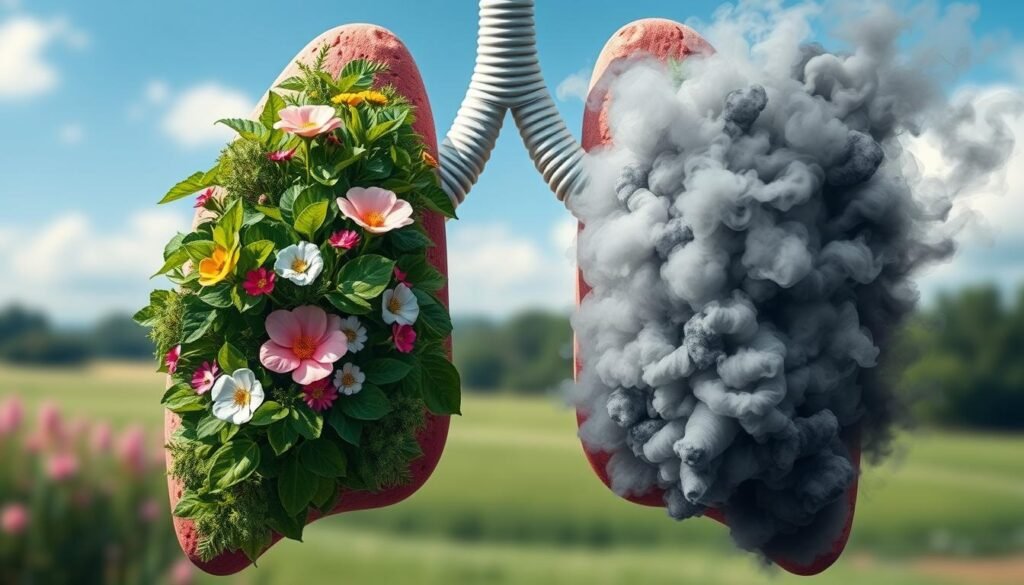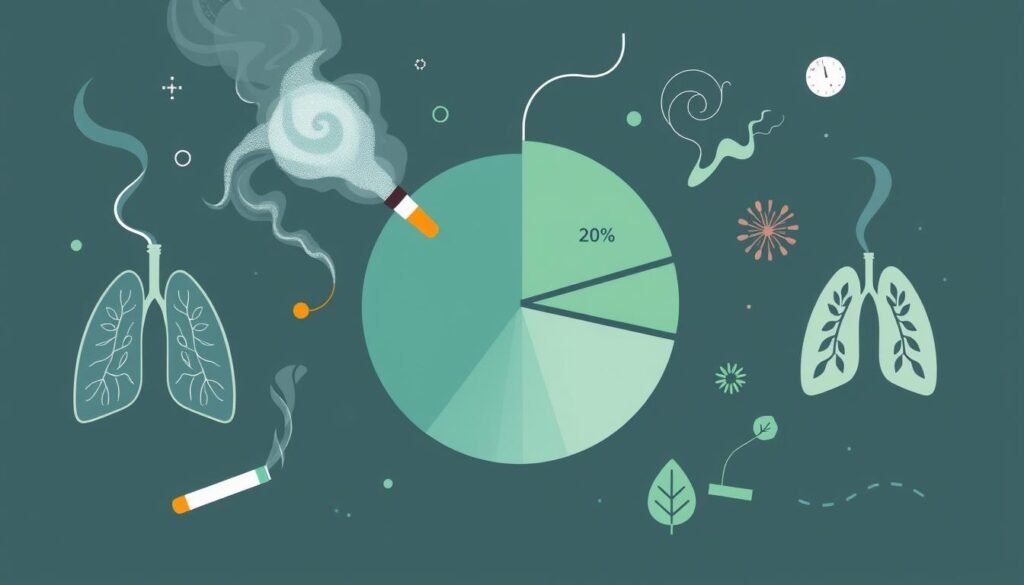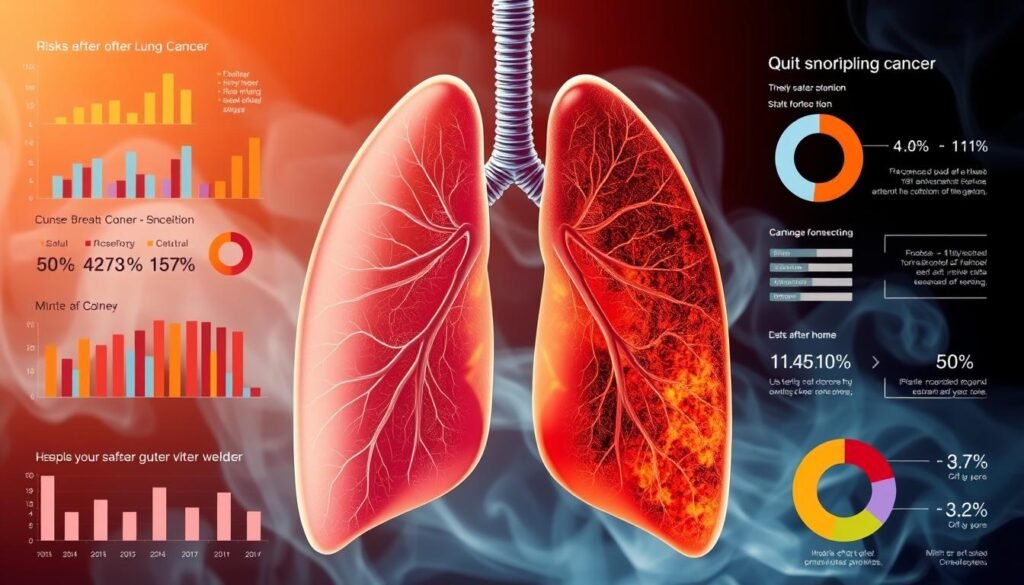Did you know former smokers not covered by US lung cancer screening guidelines have a 10-fold higher lung cancer risk than non-smokers? This shocking fact was shown in a study from JAMA Oncology. Lung cancer is the top cause of cancer deaths in the US, and smoking causes about 85% of these cases.
For people who have stopped smoking, knowing how their risk changes is vital. This article looks at the lung cancer risk for these individuals. It shows how stopping smoking affects lung health and what it means for their life expectancy. Almost half of all new lung cancer diagnoses are in former smokers, highlighting the need for awareness and preventive steps.
Key Takeaways
- Ex-smokers have a higher lung cancer risk than never-smokers, emphasizing the need for ongoing screenings.
- Smoking is linked to 85% of lung cancer cases, making cessation programs vital for health.
- Quitting smoking can significantly lower the risk of lung cancer and related diseases.
- Regular screening is crucial for early detection, especially for high-risk former smokers.
- Understanding personal lung cancer risk is key for all former smokers.
Understanding Lung Cancer Risks for Former Smokers
Even after quitting, former smokers still face a high risk of lung cancer. Smoking is linked to about 80% of lung cancer deaths, particularly with small cell lung cancer (SCLC). Though quitting smoking improves lung health, the cancer risk remains higher than for those who never smoked.
Ex-smokers face lung cancer risks due to chronic tobacco exposure. This exposure causes long-term changes and genetic abnormalities that can last for years. Consequently, over half of new lung cancer cases are in people who’ve quit smoking.
Other environmental risks also play a role. For example, past radiation therapy and exposure to asbestos or secondhand smoke increase lung cancer risks. This makes monitoring lung health critical after quitting smoking.
Lung cancer is a leading cause of cancer deaths. Despite efforts to lower smoking rates, former smokers still have significant risks. This underscores the importance of education, support, and health screenings for them.
| Risk Factors | Impact on Lung Cancer Risk |
|---|---|
| Cigarette Smoking | Increases risk by 30-fold compared to nonsmokers |
| Secondhand Smoke | Third most common cause of lung cancer |
| Radon Exposure | Second leading cause of lung cancer among non-smokers |
| Asbestos Exposure | Significantly increases lung cancer mortality, especially when combined with smoking |
| Air Pollution | Contributes to 1-2% of lung cancer deaths |
| Genetic Factors | Family history may elevate risk slightly |
Impact of Smoking Cessation on Lung Health
Quitting smoking greatly improves lung health. People feel better in just a few weeks. They breathe easier too. This shows how stopping smoking quickly benefits your lungs and cuts lung cancer risk. Over time, these benefits include not just easier breathing but also a lower chance of getting cancer.
Stopping smoking affects lung tissues and cells. This is key to understanding its overall health benefits. Research has found that quitting smoking boosts survival chances if lung cancer occurs. Specifically, those who quit years before being diagnosed have a much lower *reduction* in cancer risk. This proves quitting smoking early really helps lower cancer risk.
Lung cancer is still a major deadly disease. About 75% of lung cancer patients die within five years of finding out they have it. This makes quitting smoking a life-saving choice. Lung cancer rates differ greatly between smokers and non-smokers. Smokers have a higher rate of 1.97 per 1,000 people, compared to 1.61 for former smokers. This highlights why quitting smoking is so important.

Percentage of Ex Smokers Who Get Lung Cancer
The link between stopping smoking and the risk of lung cancer is very important. It’s crucial to know the stats. They help us understand how likely it is for ex-smokers to get lung cancer. Studies show that about 40% of lung cancers are found in people who quit smoking more than 15 years ago. This tells us that even after quitting, the risk of lung cancer remains.
Statistics on Lung Cancer in Ex-Smokers
The number of lung cancer cases in people who have quit smoking is quite high. The risk depends on when they stopped smoking. For example, quitting at 30 means a 2% risk, but stopping at 60 means a 10% risk. About 80% to 90% of all lung cancer cases come from smoking. In contrast, people who never smoked have only a 1.8% risk, while former smokers have a 7.2% risk.
Factors Influencing Lung Cancer Prevalence in Former Smokers
Many things affect lung cancer risk in people who have stopped smoking. Important factors include:
- Number of pack-years smoked
- Age at which smoking was ceased
- The types of cigarettes used, especially those with more tar and nicotine
- Socioeconomic status, as it can impact access to health care and screening
Knowing these factors helps in assessing risks and preventing disease. Research, including studies found here, shows the value of lung cancer screenings for past smokers. By being aware of the high rates of lung cancer among ex-smokers, individuals can make smart decisions about their health after quitting smoking.

| Age at Quitting | Cumulative Lung Cancer Risk |
|---|---|
| 30 years | 2% |
| 40 years | 3% |
| 50 years | 6% |
| 60 years | 10% |
By knowing the risks and getting regular screenings, former smokers can work to lower their chance of lung cancer over time.
Cancer Risk Reduction After Quitting Smoking
Quitting smoking helps lower the risk of cancer, especially lung cancer. This is true no matter how old you are. Quitting early in life can greatly boost health and longevity.
How Quitting Improves Life Expectancy
Studies show that quitting smoking can add up to 10 years to your life. For those who quit before 40, there’s a 90% lower risk of dying from smoking-related diseases. This shows how important quitting is for both immediate and future health.
Effects of Age and Duration of Smoking on Cancer Risk
The sooner you quit smoking, the lower your cancer risk will be. If you quit by age 50, you cut your lung cancer risk by 57%. Quitting after 50 still brings a 40% lower risk of lung cancer. Even though some risk remains, quitting as soon as possible is key to better long-term health and living longer.
Lung Cancer Statistics After Quitting Smoking
Research shows big findings on lung cancer after quitting smoking. People who stop smoking cut their lung cancer risk a lot compared to those who keep smoking. The risk drops a lot soon after quitting and keeps going down over time.
After quitting for a year, an 81.4% risk of lung cancer remains. At five years, this goes down to 57.2%. Ten years later, it reduces to 36.9%. By fifteen years, it’s at 26.7%, and twenty years sees it at 19.7%. These numbers show that the longer you don’t smoke, the more your lung cancer risk decreases.

Ex-smokers still have a higher lung cancer risk than never-smokers. In particular, heavy ex-smokers have a risk 12.12 times greater than those who never smoked, even five years after quitting. Their risk remains about three times higher after many years.
Quitting smoking reduces cancer risk a lot. Ex-smokers see a 17% lower overall cancer risk. Risks of liver, stomach, and colorectal cancer drop by 27%, 14%, and 20%, respectively. Lung cancer risk also decreases quickly, showing quitting is crucial for health.
It’s important to have screening for ex-smokers. Guidelines suggest making more ex-smokers eligible for lung cancer screening. This could lead to finding cancer earlier and improving chances of survival.
Long-Term Effects of Smoking History on Lung Cancer Incidence
Your smoking history plays a big role in your lung cancer risk, even after you quit. The term “pack-year” helps us understand this risk among former smokers. The more you smoked in the past, the higher your risk remains, even years after stopping.
This section will explore how your smoking habits affect lung cancer chances. It stresses the importance of knowing your pack-year number.
Understanding Pack-Year History and Its Impact
Knowing your pack-year number is key to understanding lung cancer risk. A pack-year means smoking one pack a day for a year. Research shows that people who smoked a lot and then quit still have a high lung cancer risk years later. In fact, 40.8% of lung cancer cases in former smokers happen more than 15 years after they’ve quit.
As time goes by, a former smoker’s lung cancer risk lowers, but this change depends on their smoking past. The differences are clear when we look at numbers:
| Years Since Quitting (YSQ) | Hazard Ratio (HR) |
|---|---|
| < 5 YSQ | 12.12 |
| 5 – 9 YSQ | 11.77 |
| 10 – 14 YSQ | 7.81 |
| 15 – 24 YSQ | 5.88 |
| ≥ 25 YSQ | 3.85 |
If you smoked a lot for many years, your lung cancer risk stays high. Lifetime risk for male and female former smokers is significantly more than for those who never smoked. Those with a heavy smoking past should get checked often. Early checks can cut lung cancer death rates by as much as 38%, especially if you’ve stopped smoking.
It’s crucial for former smokers to know the lasting impacts of their smoking on lung cancer risks. Being alert and getting screened for lung cancer is key. Taking action early can greatly improve your health down the road.
Regular Screenings for Ex-Smokers
Lung cancer is a big issue, especially for those who used to smoke. Getting checked regularly can catch it early and lead to better results. Recommendations suggest yearly CT scans for 50 to 80-year-olds with a 20 pack-year history of smoking. Even if you’ve quit smoking in the last 15 years, you should still get screened. Early detection is key, as finding lung cancer late has a much worse survival rate.
Who Should Get Screened for Lung Cancer?
If you’re between 50 and 80 and have a heavy smoking history, you should consider screenings. This advice also applies to people who’ve stopped smoking for over 15 years. In 2020, about 228,820 people in the U.S. were told they have lung cancer. Knowing who should get screened is crucial.
The Role of Low-Dose CT Scans in Early Detection
Low-dose CT scans are great at finding lung cancer early. A big study showed yearly screenings for three years can make a huge difference. But many people ignore lung cancer screenings, even though they get checked for other cancers. We need to make everyone more aware of lung cancer and how to prevent it through regular checks.
| Screening Criteria | Recommendations |
|---|---|
| Aged 50-80 years | Annual low-dose CT scans |
| 20 pack-year smoking history | Screening eligibility confirmed |
| Quit smoking for 15 years or longer | Continue screening recommendations |
Common Symptoms of Lung Cancer to Watch For
Spotting early lung cancer symptoms is key to effective treatment. Key signs to look for include:
- Persistent cough: A cough that stays or gets worse over time.
- Chest pain: Pain that increases with deep breaths, coughs, or laughter.
- Unexplained weight loss: Losing weight suddenly without diet or exercise changes.
- Shortness of breath: New or odd trouble breathing or wheezing.
- Fatigue: Feeling unusually tired without relief from resting.
Both current and former smokers should be extra watchful. Catching symptoms early can lead to better disease management.
Making efforts in lung cancer prevention is also crucial. This includes staying informed and making healthy life choices. Getting regular check-ups and screenings helps find problems early.
| Symptom | Description |
|---|---|
| Persistent Cough | A cough that persists and doesn’t improve. |
| Chest Pain | Can be sharp or dull, getting worse with movement. |
| Weight Loss | Unexpected and significant weight drop. |
| Shortness of Breath | Breathing becomes more difficult than usual. |
| Fatigue | Constant tiredness that doesn’t get better with rest. |
Conclusion
Quitting smoking leads to better lung health and lowers lung cancer risk over time. But, dangers from past smoking can still lurk. Yet, evidence is clear that stopping smoking boosts health greatly. Over 60% of cancer patients used to smoke or still do. This fact shows how crucial it is for former smokers to prevent lung cancer by staying alert and getting regular checks.
People who stop smoking before turning 50 cut their risk of dying in the next 15 years by half, compared to those who keep smoking. Quitting not just slashes lung cancer risk—it means a longer, healthier life too. Despite the ongoing risks, quitting smoking has more pros than cons.
The journey of an ex-smoker is filled with hope and chances for better health. Staying aware and getting regular screenings are key to fight against lung cancer. Embracing a life without smoke promises a brighter future.